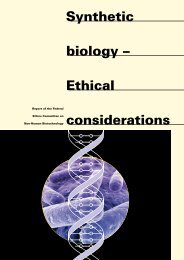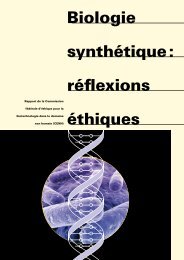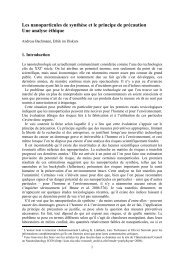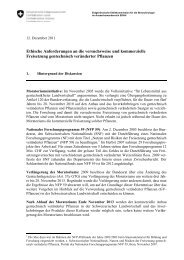Helmut Segner Fish Nociception and pain A biological perspective
Helmut Segner Fish Nociception and pain A ... - EKAH - admin.ch
Helmut Segner Fish Nociception and pain A ... - EKAH - admin.ch
- No tags were found...
You also want an ePaper? Increase the reach of your titles
YUMPU automatically turns print PDFs into web optimized ePapers that Google loves.
2. <strong>Nociception</strong> <strong>and</strong> <strong>pain</strong> perception in man<br />
ception in fish. The discussion will focus on acute <strong>pain</strong>, neglecting<br />
other aspects of <strong>pain</strong> such as chronic <strong>pain</strong> or the modulation of<br />
<strong>pain</strong> experience by psychological factors, for instance, individual<br />
attitudes <strong>and</strong> beliefs.<br />
Pain perception in man is a sensation that results from three major<br />
steps (Figure 1):<br />
• peripheral nociception, that is the sensing of noxious stimuli in<br />
peripheral organs such as skin, viscera, etc.,<br />
• processing of nociceptive information at the spinal cord level,<br />
<strong>and</strong> transmission to the brain,<br />
• processing of the nociceptive information in the brain.<br />
It is this processing of nociceptive message in the brain that turns<br />
the nociceptive signal into the sensation we perceive as “<strong>pain</strong>”. Pain<br />
arises from the integration of a sensory-discriminative component,<br />
which records intensity, location, <strong>and</strong> modality of the noxious stimuli,<br />
with an affective-cognitive component, which associates the<br />
nociceptive input with cognitive properties (e. g., attention, memory)<br />
<strong>and</strong> with emotional properties (e. g., fear, unpleasantness)<br />
(Millan 1999, Peyron et al. 2000). As formulated by Tracey (2005),<br />
<strong>pain</strong> is “an interpretation of the nociceptive input influenced by<br />
memories, emotional, pathological <strong>and</strong> cognitive factors”.<br />
Perceiving <strong>pain</strong> leads to behavioural <strong>pain</strong> expression <strong>and</strong> (protective)<br />
responses. These reactions are governed both by automatic<br />
processes (unintentional/reflexive, for instance, screaming,<br />
vocaling, withdrawal reflex) <strong>and</strong> controlled processes (intentional/<br />
purposive, for instance, sequences of instrumental motor activity)<br />
(Craig et al. 2010). Neuro-anatomically, these reactions are<br />
anchored in the brainstem (e. g., reticular area, globus pallosa), in<br />
subcortical regions such as thalamus, as well as in the cortex (Rose<br />
2002, Braz et al. 2005).<br />
In the following, the three steps leading from nociception to<br />
<strong>pain</strong> perception will be discussed with respect to man. This is intended<br />
to provide a basis for discussing nociception <strong>and</strong> <strong>pain</strong> per-<br />
ascending<br />
nociceptive<br />
pathways<br />
endogenous<br />
injury<br />
Brain:<br />
nociceptive processing,<br />
<strong>pain</strong> perception<br />
• cordical<br />
• subcordical<br />
descending<br />
(faciliating/onhibitory)<br />
pathways<br />
Spinal cord:<br />
nociceptive processing<br />
<strong>and</strong> transmission<br />
nociceptive input<br />
nociceptors<br />
exogenous<br />
noxius stimuli<br />
Figure 1: Schematic overview of key<br />
elements in <strong>pain</strong> perception:<br />
peripheral nociception, spinal cord<br />
processing <strong>and</strong> transmission, <strong>and</strong><br />
brain processing<br />
14 <strong>Fish</strong>. <strong>Nociception</strong> <strong>and</strong> <strong>pain</strong> | Contributions to Ethics <strong>and</strong> Biotechnology<br />
<strong>Fish</strong>. <strong>Nociception</strong> <strong>and</strong> <strong>pain</strong> | Contributions to Ethics <strong>and</strong> Biotechnology<br />
15









